CULTURE AND COMMUNICATIONMade by: Ibirkhanov A. N gr.

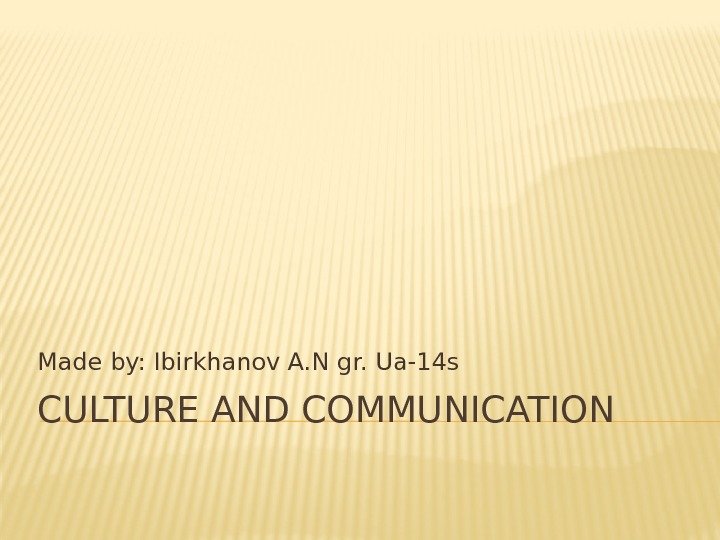
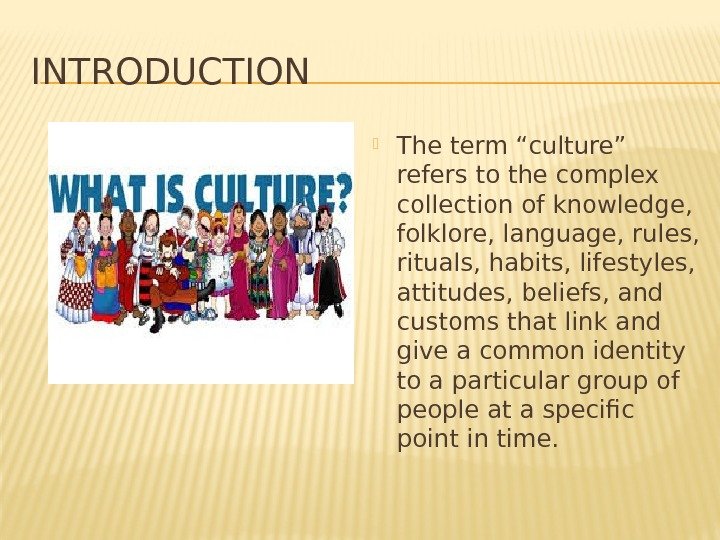
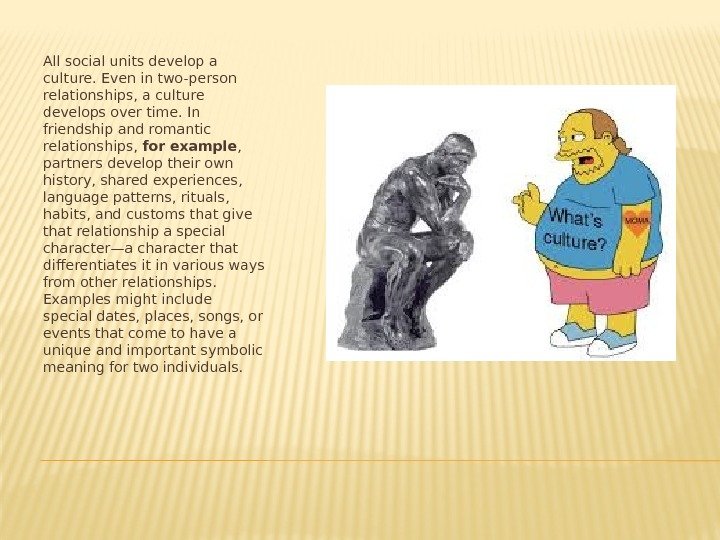
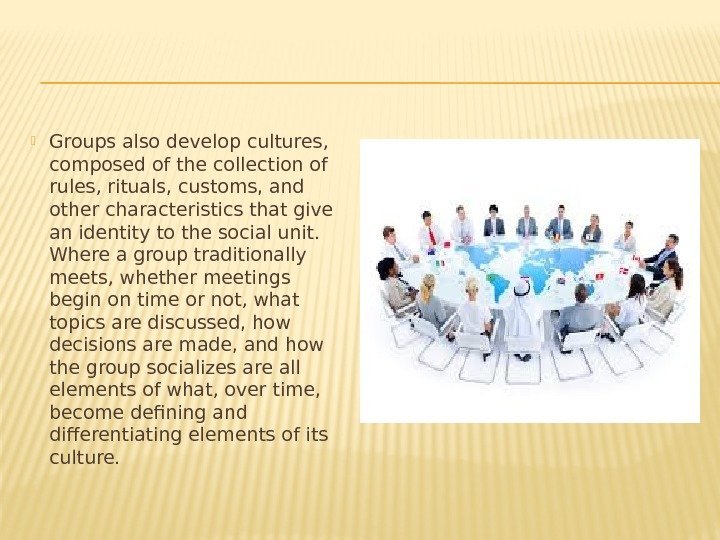
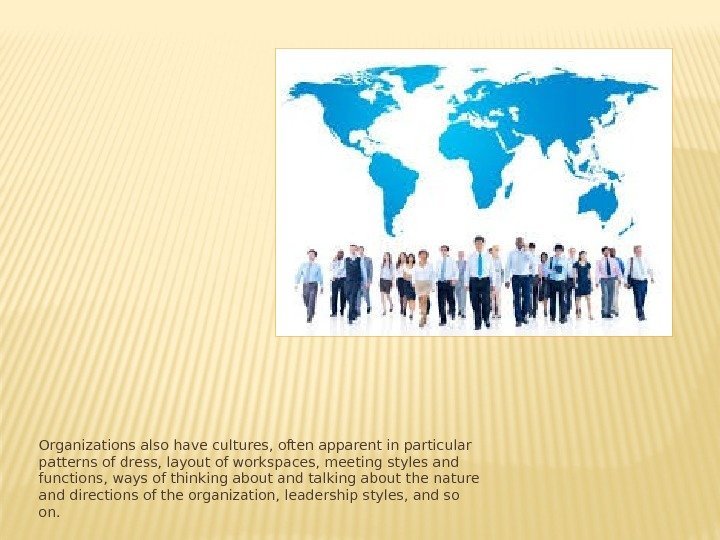
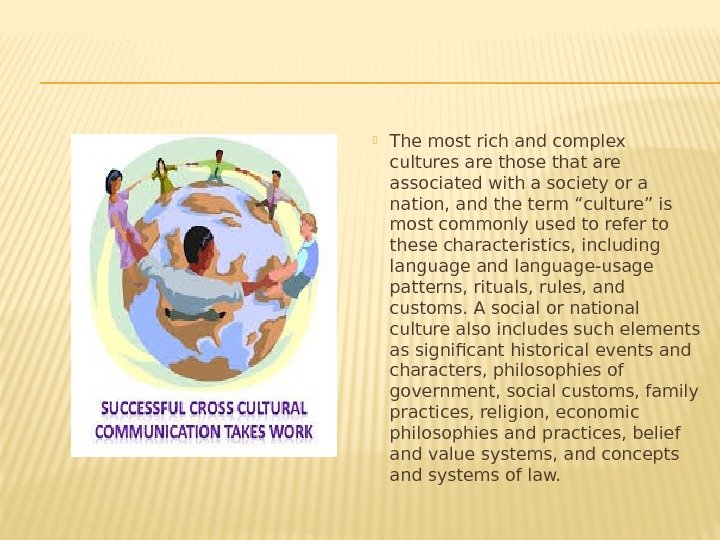
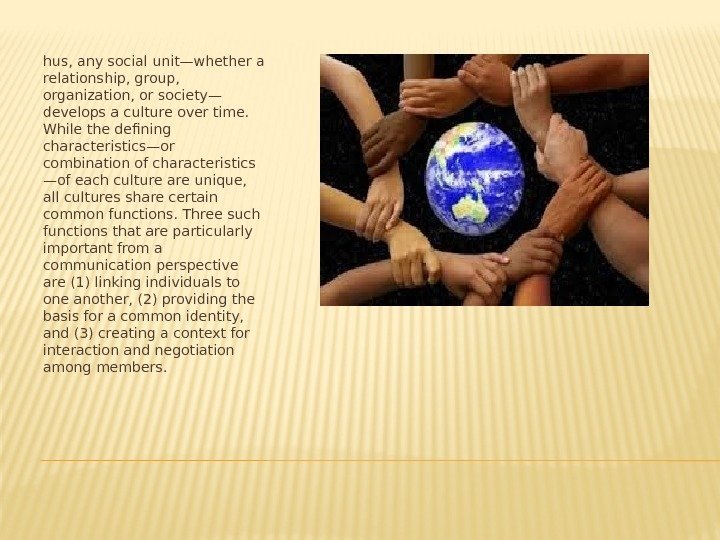
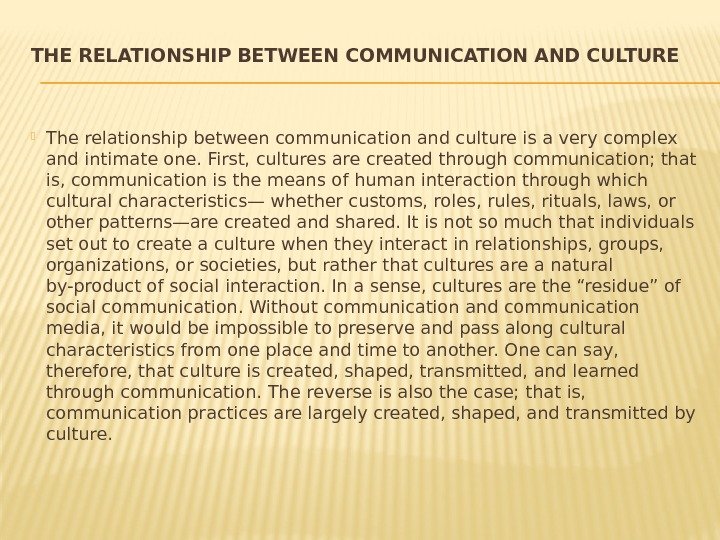
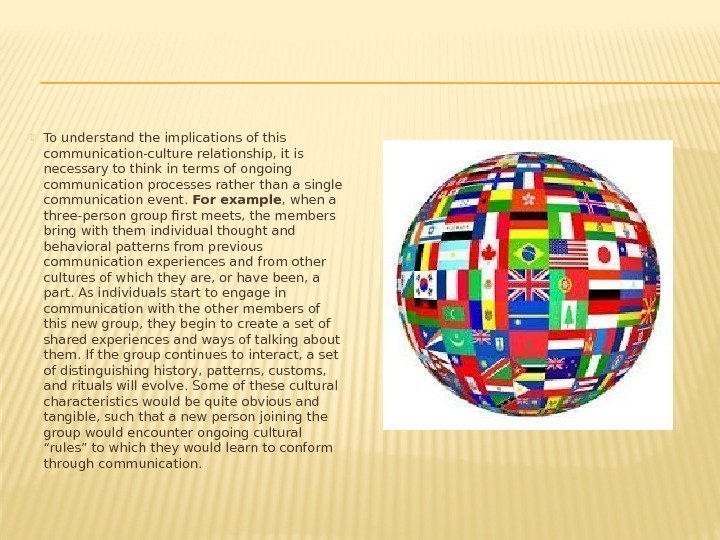
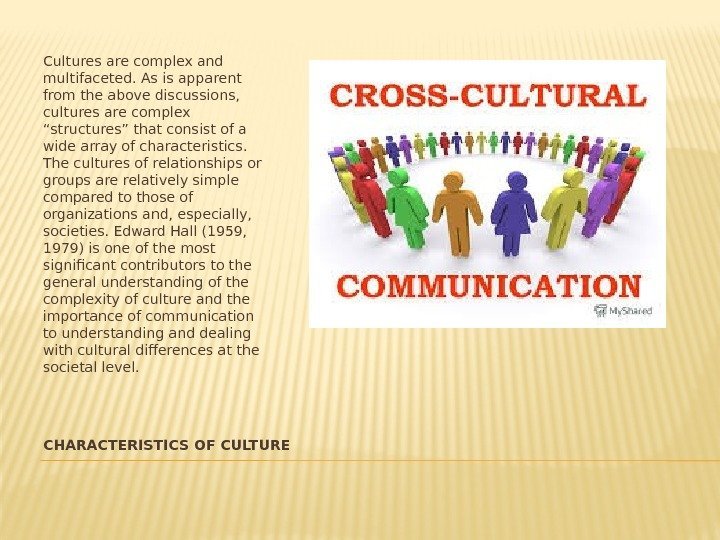
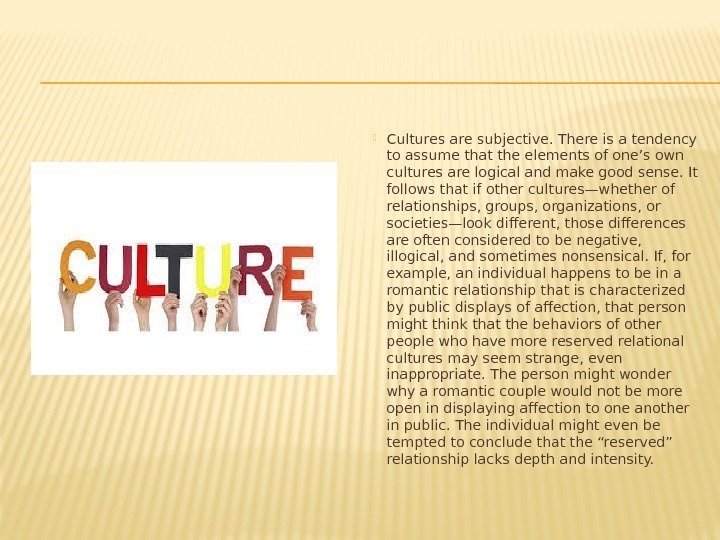
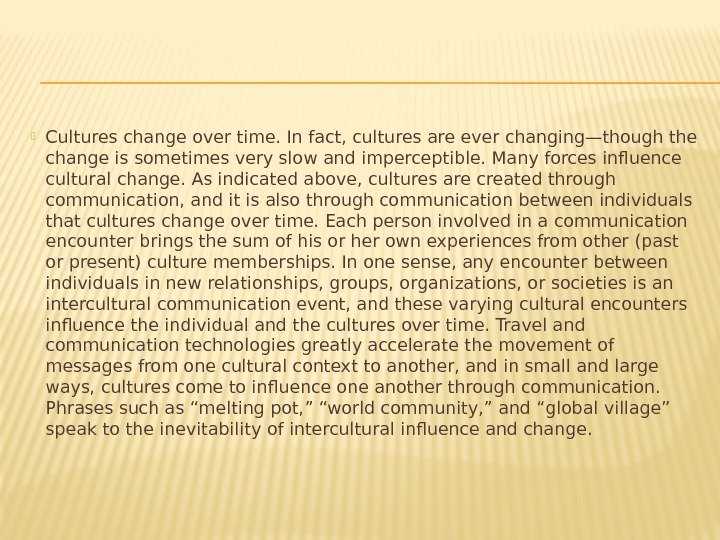
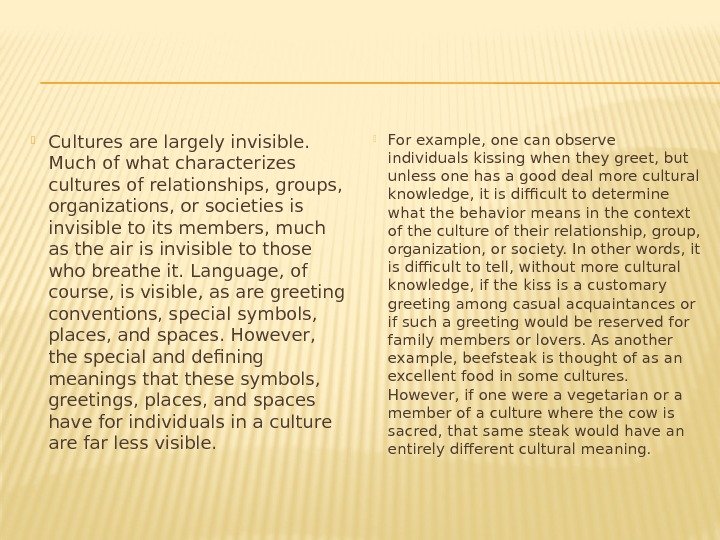
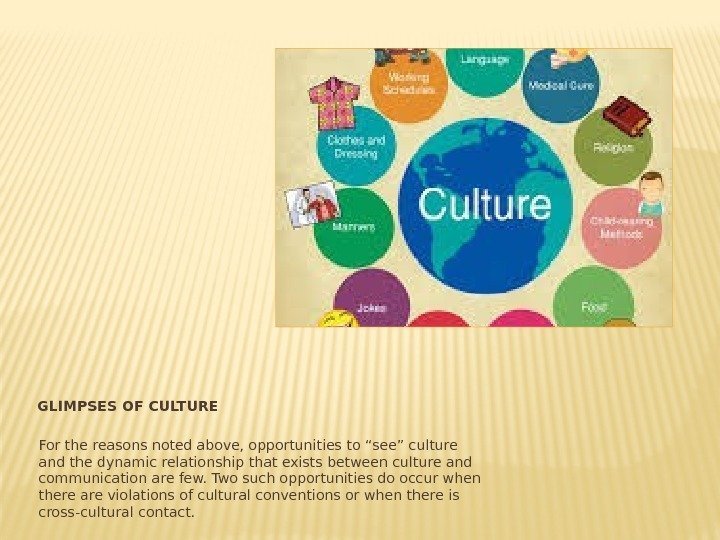
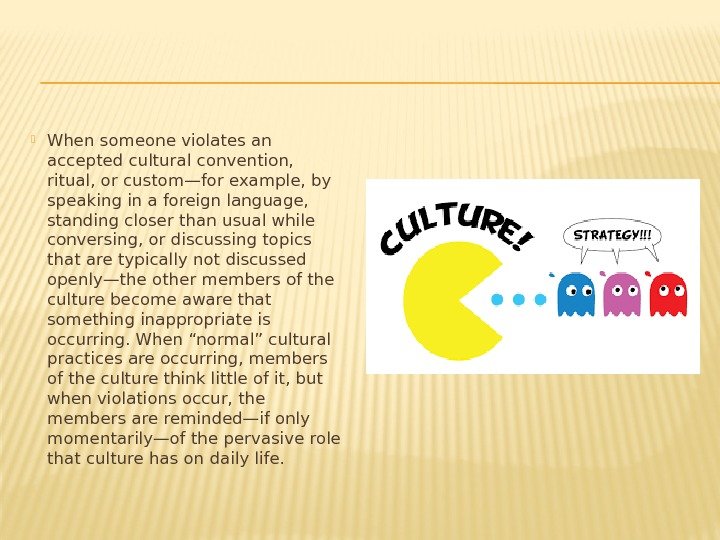
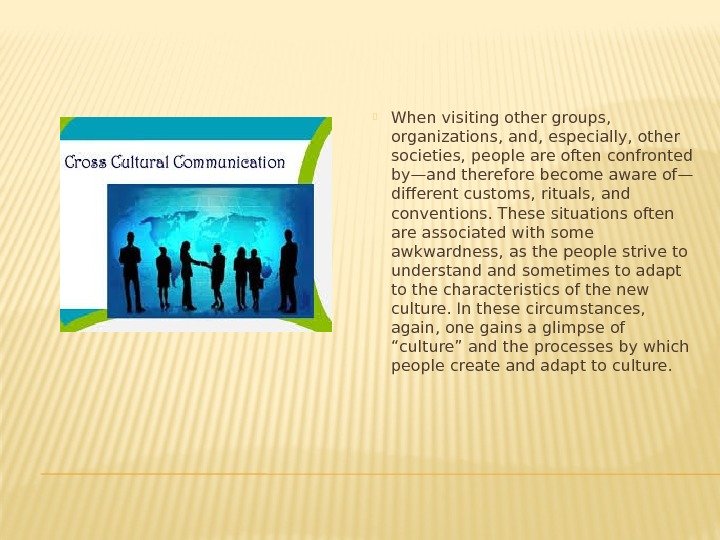
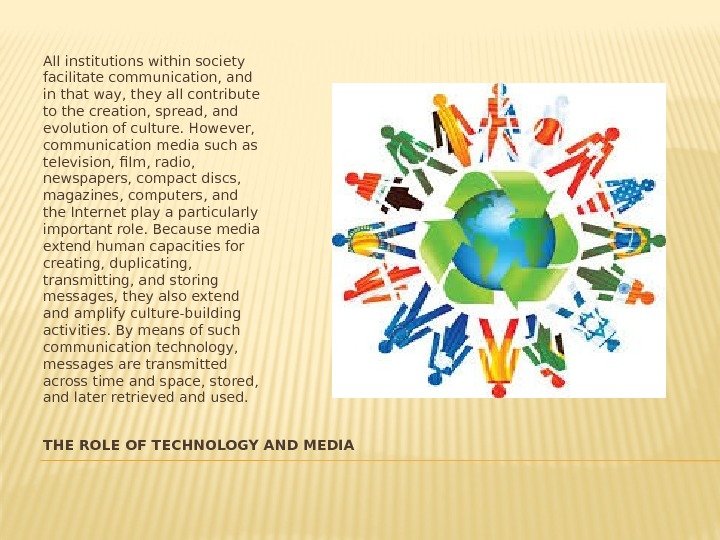
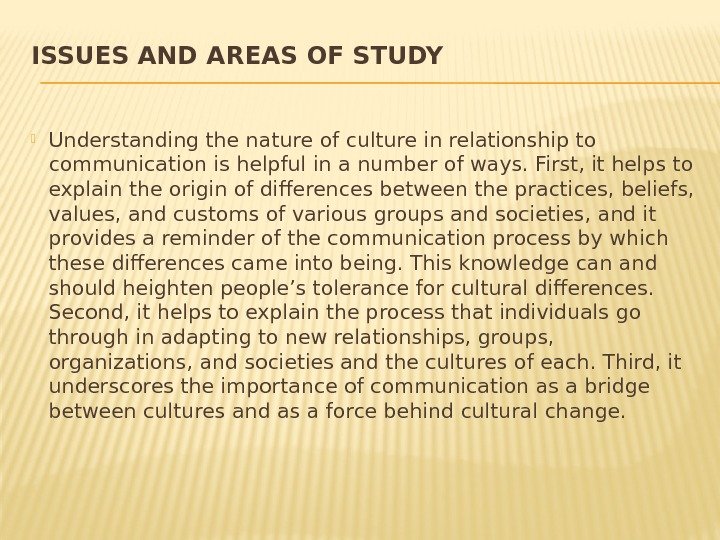
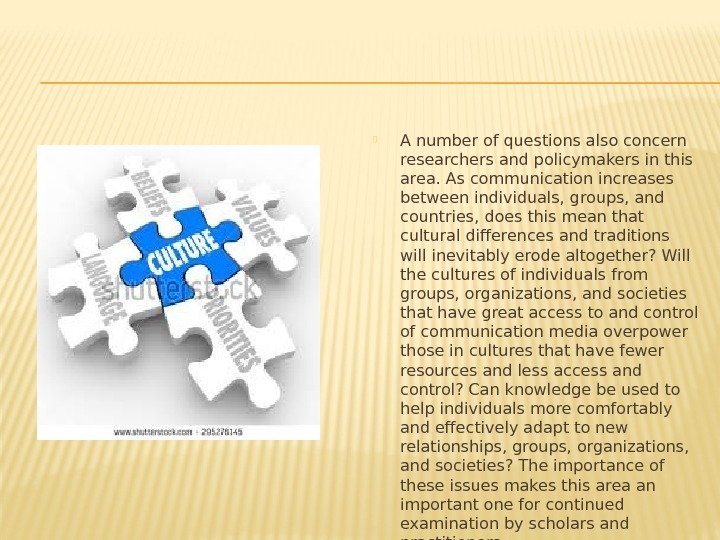

culture_and_communication.pptx
- Размер: 359.6 Кб
- Автор:
- Количество слайдов: 20
Описание презентации CULTURE AND COMMUNICATIONMade by: Ibirkhanov A. N gr. по слайдам
 CULTURE AND COMMUNICATIONMade by: Ibirkhanov A. N gr. Ua-14 s
CULTURE AND COMMUNICATIONMade by: Ibirkhanov A. N gr. Ua-14 s
 INTRODUCTION The term “culture” refers to the complex collection of knowledge, folklore, language, rules, rituals, habits, lifestyles, attitudes, beliefs, and customs that link and give a common identity to a particular group of people at a specific point in time.
INTRODUCTION The term “culture” refers to the complex collection of knowledge, folklore, language, rules, rituals, habits, lifestyles, attitudes, beliefs, and customs that link and give a common identity to a particular group of people at a specific point in time.
 All social units develop a culture. Even in two-person relationships, a culture develops over time. In friendship and romantic relationships, for example , partners develop their own history, shared experiences, language patterns, rituals, habits, and customs that give that relationship a special character—a character that differentiates it in various ways from other relationships. Examples might include special dates, places, songs, or events that come to have a unique and important symbolic meaning for two individuals.
All social units develop a culture. Even in two-person relationships, a culture develops over time. In friendship and romantic relationships, for example , partners develop their own history, shared experiences, language patterns, rituals, habits, and customs that give that relationship a special character—a character that differentiates it in various ways from other relationships. Examples might include special dates, places, songs, or events that come to have a unique and important symbolic meaning for two individuals.
 Groups also develop cultures, composed of the collection of rules, rituals, customs, and other characteristics that give an identity to the social unit. Where a group traditionally meets, whether meetings begin on time or not, what topics are discussed, how decisions are made, and how the group socializes are all elements of what, over time, become defining and differentiating elements of its culture.
Groups also develop cultures, composed of the collection of rules, rituals, customs, and other characteristics that give an identity to the social unit. Where a group traditionally meets, whether meetings begin on time or not, what topics are discussed, how decisions are made, and how the group socializes are all elements of what, over time, become defining and differentiating elements of its culture.
 Organizations also have cultures, often apparent in particular patterns of dress, layout of workspaces, meeting styles and functions, ways of thinking about and talking about the nature and directions of the organization, leadership styles, and so on.
Organizations also have cultures, often apparent in particular patterns of dress, layout of workspaces, meeting styles and functions, ways of thinking about and talking about the nature and directions of the organization, leadership styles, and so on.
 The most rich and complex cultures are those that are associated with a society or a nation, and the term “culture” is most commonly used to refer to these characteristics, including language and language-usage patterns, rituals, rules, and customs. A social or national culture also includes such elements as significant historical events and characters, philosophies of government, social customs, family practices, religion, economic philosophies and practices, belief and value systems, and concepts and systems of law.
The most rich and complex cultures are those that are associated with a society or a nation, and the term “culture” is most commonly used to refer to these characteristics, including language and language-usage patterns, rituals, rules, and customs. A social or national culture also includes such elements as significant historical events and characters, philosophies of government, social customs, family practices, religion, economic philosophies and practices, belief and value systems, and concepts and systems of law.
 hus, any social unit—whether a relationship, group, organization, or society— develops a culture over time. While the defining characteristics—or combination of characteristics —of each culture are unique, all cultures share certain common functions. Three such functions that are particularly important from a communication perspective are (1) linking individuals to one another, (2) providing the basis for a common identity, and (3) creating a context for interaction and negotiation among members.
hus, any social unit—whether a relationship, group, organization, or society— develops a culture over time. While the defining characteristics—or combination of characteristics —of each culture are unique, all cultures share certain common functions. Three such functions that are particularly important from a communication perspective are (1) linking individuals to one another, (2) providing the basis for a common identity, and (3) creating a context for interaction and negotiation among members.
 THE RELATIONSHIP BETWEEN COMMUNICATION AND CULTURE The relationship between communication and culture is a very complex and intimate one. First, cultures are created through communication; that is, communication is the means of human interaction through which cultural characteristics— whether customs, roles, rules, rituals, laws, or other patterns—are created and shared. It is not so much that individuals set out to create a culture when they interact in relationships, groups, organizations, or societies, but rather that cultures are a natural by-product of social interaction. In a sense, cultures are the “residue” of social communication. Without communication and communication media, it would be impossible to preserve and pass along cultural characteristics from one place and time to another. One can say, therefore, that culture is created, shaped, transmitted, and learned through communication. The reverse is also the case; that is, communication practices are largely created, shaped, and transmitted by culture.
THE RELATIONSHIP BETWEEN COMMUNICATION AND CULTURE The relationship between communication and culture is a very complex and intimate one. First, cultures are created through communication; that is, communication is the means of human interaction through which cultural characteristics— whether customs, roles, rules, rituals, laws, or other patterns—are created and shared. It is not so much that individuals set out to create a culture when they interact in relationships, groups, organizations, or societies, but rather that cultures are a natural by-product of social interaction. In a sense, cultures are the “residue” of social communication. Without communication and communication media, it would be impossible to preserve and pass along cultural characteristics from one place and time to another. One can say, therefore, that culture is created, shaped, transmitted, and learned through communication. The reverse is also the case; that is, communication practices are largely created, shaped, and transmitted by culture.
 To understand the implications of this communication-culture relationship, it is necessary to think in terms of ongoing communication processes rather than a single communication event. For example , when a three-person group first meets, the members bring with them individual thought and behavioral patterns from previous communication experiences and from other cultures of which they are, or have been, a part. As individuals start to engage in communication with the other members of this new group, they begin to create a set of shared experiences and ways of talking about them. If the group continues to interact, a set of distinguishing history, patterns, customs, and rituals will evolve. Some of these cultural characteristics would be quite obvious and tangible, such that a new person joining the group would encounter ongoing cultural “rules” to which they would learn to conform through communication.
To understand the implications of this communication-culture relationship, it is necessary to think in terms of ongoing communication processes rather than a single communication event. For example , when a three-person group first meets, the members bring with them individual thought and behavioral patterns from previous communication experiences and from other cultures of which they are, or have been, a part. As individuals start to engage in communication with the other members of this new group, they begin to create a set of shared experiences and ways of talking about them. If the group continues to interact, a set of distinguishing history, patterns, customs, and rituals will evolve. Some of these cultural characteristics would be quite obvious and tangible, such that a new person joining the group would encounter ongoing cultural “rules” to which they would learn to conform through communication.
 CHARACTERISTICS OF CULTURECultures are complex and multifaceted. As is apparent from the above discussions, cultures are complex “structures” that consist of a wide array of characteristics. The cultures of relationships or groups are relatively simple compared to those of organizations and, especially, societies. Edward Hall (1959, 1979) is one of the most significant contributors to the general understanding of the complexity of culture and the importance of communication to understanding and dealing with cultural differences at the societal level.
CHARACTERISTICS OF CULTURECultures are complex and multifaceted. As is apparent from the above discussions, cultures are complex “structures” that consist of a wide array of characteristics. The cultures of relationships or groups are relatively simple compared to those of organizations and, especially, societies. Edward Hall (1959, 1979) is one of the most significant contributors to the general understanding of the complexity of culture and the importance of communication to understanding and dealing with cultural differences at the societal level.
 Cultures are subjective. There is a tendency to assume that the elements of one’s own cultures are logical and make good sense. It follows that if other cultures—whether of relationships, groups, organizations, or societies—look different, those differences are often considered to be negative, illogical, and sometimes nonsensical. If, for example, an individual happens to be in a romantic relationship that is characterized by public displays of affection, that person might think that the behaviors of other people who have more reserved relational cultures may seem strange, even inappropriate. The person might wonder why a romantic couple would not be more open in displaying affection to one another in public. The individual might even be tempted to conclude that the “reserved” relationship lacks depth and intensity.
Cultures are subjective. There is a tendency to assume that the elements of one’s own cultures are logical and make good sense. It follows that if other cultures—whether of relationships, groups, organizations, or societies—look different, those differences are often considered to be negative, illogical, and sometimes nonsensical. If, for example, an individual happens to be in a romantic relationship that is characterized by public displays of affection, that person might think that the behaviors of other people who have more reserved relational cultures may seem strange, even inappropriate. The person might wonder why a romantic couple would not be more open in displaying affection to one another in public. The individual might even be tempted to conclude that the “reserved” relationship lacks depth and intensity.
 Cultures change over time. In fact, cultures are ever changing—though the change is sometimes very slow and imperceptible. Many forces influence cultural change. As indicated above, cultures are created through communication, and it is also through communication between individuals that cultures change over time. Each person involved in a communication encounter brings the sum of his or her own experiences from other (past or present) culture memberships. In one sense, any encounter between individuals in new relationships, groups, organizations, or societies is an intercultural communication event, and these varying cultural encounters influence the individual and the cultures over time. Travel and communication technologies greatly accelerate the movement of messages from one cultural context to another, and in small and large ways, cultures come to influence one another through communication. Phrases such as “melting pot, ” “world community, ” and “global village” speak to the inevitability of intercultural influence and change.
Cultures change over time. In fact, cultures are ever changing—though the change is sometimes very slow and imperceptible. Many forces influence cultural change. As indicated above, cultures are created through communication, and it is also through communication between individuals that cultures change over time. Each person involved in a communication encounter brings the sum of his or her own experiences from other (past or present) culture memberships. In one sense, any encounter between individuals in new relationships, groups, organizations, or societies is an intercultural communication event, and these varying cultural encounters influence the individual and the cultures over time. Travel and communication technologies greatly accelerate the movement of messages from one cultural context to another, and in small and large ways, cultures come to influence one another through communication. Phrases such as “melting pot, ” “world community, ” and “global village” speak to the inevitability of intercultural influence and change.
 Cultures are largely invisible. Much of what characterizes cultures of relationships, groups, organizations, or societies is invisible to its members, much as the air is invisible to those who breathe it. Language, of course, is visible, as are greeting conventions, special symbols, places, and spaces. However, the special and defining meanings that these symbols, greetings, places, and spaces have for individuals in a culture are far less visible. For example, one can observe individuals kissing when they greet, but unless one has a good deal more cultural knowledge, it is difficult to determine what the behavior means in the context of the culture of their relationship, group, organization, or society. In other words, it is difficult to tell, without more cultural knowledge, if the kiss is a customary greeting among casual acquaintances or if such a greeting would be reserved for family members or lovers. As another example, beefsteak is thought of as an excellent food in some cultures. However, if one were a vegetarian or a member of a culture where the cow is sacred, that same steak would have an entirely different cultural meaning.
Cultures are largely invisible. Much of what characterizes cultures of relationships, groups, organizations, or societies is invisible to its members, much as the air is invisible to those who breathe it. Language, of course, is visible, as are greeting conventions, special symbols, places, and spaces. However, the special and defining meanings that these symbols, greetings, places, and spaces have for individuals in a culture are far less visible. For example, one can observe individuals kissing when they greet, but unless one has a good deal more cultural knowledge, it is difficult to determine what the behavior means in the context of the culture of their relationship, group, organization, or society. In other words, it is difficult to tell, without more cultural knowledge, if the kiss is a customary greeting among casual acquaintances or if such a greeting would be reserved for family members or lovers. As another example, beefsteak is thought of as an excellent food in some cultures. However, if one were a vegetarian or a member of a culture where the cow is sacred, that same steak would have an entirely different cultural meaning.
 GLIMPSES OF CULTURE For the reasons noted above, opportunities to “see” culture and the dynamic relationship that exists between culture and communication are few. Two such opportunities do occur when there are violations of cultural conventions or when there is cross-cultural contact.
GLIMPSES OF CULTURE For the reasons noted above, opportunities to “see” culture and the dynamic relationship that exists between culture and communication are few. Two such opportunities do occur when there are violations of cultural conventions or when there is cross-cultural contact.
 When someone violates an accepted cultural convention, ritual, or custom—for example, by speaking in a foreign language, standing closer than usual while conversing, or discussing topics that are typically not discussed openly—the other members of the culture become aware that something inappropriate is occurring. When “normal” cultural practices are occurring, members of the culture think little of it, but when violations occur, the members are reminded—if only momentarily—of the pervasive role that culture has on daily life.
When someone violates an accepted cultural convention, ritual, or custom—for example, by speaking in a foreign language, standing closer than usual while conversing, or discussing topics that are typically not discussed openly—the other members of the culture become aware that something inappropriate is occurring. When “normal” cultural practices are occurring, members of the culture think little of it, but when violations occur, the members are reminded—if only momentarily—of the pervasive role that culture has on daily life.
 When visiting other groups, organizations, and, especially, other societies, people are often confronted by—and therefore become aware of— different customs, rituals, and conventions. These situations often are associated with some awkwardness, as the people strive to understand sometimes to adapt to the characteristics of the new culture. In these circumstances, again, one gains a glimpse of “culture” and the processes by which people create and adapt to culture.
When visiting other groups, organizations, and, especially, other societies, people are often confronted by—and therefore become aware of— different customs, rituals, and conventions. These situations often are associated with some awkwardness, as the people strive to understand sometimes to adapt to the characteristics of the new culture. In these circumstances, again, one gains a glimpse of “culture” and the processes by which people create and adapt to culture.
 THE ROLE OF TECHNOLOGY AND MEDIAAll institutions within society facilitate communication, and in that way, they all contribute to the creation, spread, and evolution of culture. However, communication media such as television, film, radio, newspapers, compact discs, magazines, computers, and the Internet play a particularly important role. Because media extend human capacities for creating, duplicating, transmitting, and storing messages, they also extend amplify culture-building activities. By means of such communication technology, messages are transmitted across time and space, stored, and later retrieved and used.
THE ROLE OF TECHNOLOGY AND MEDIAAll institutions within society facilitate communication, and in that way, they all contribute to the creation, spread, and evolution of culture. However, communication media such as television, film, radio, newspapers, compact discs, magazines, computers, and the Internet play a particularly important role. Because media extend human capacities for creating, duplicating, transmitting, and storing messages, they also extend amplify culture-building activities. By means of such communication technology, messages are transmitted across time and space, stored, and later retrieved and used.
 ISSUES AND AREAS OF STUDY Understanding the nature of culture in relationship to communication is helpful in a number of ways. First, it helps to explain the origin of differences between the practices, beliefs, values, and customs of various groups and societies, and it provides a reminder of the communication process by which these differences came into being. This knowledge can and should heighten people’s tolerance for cultural differences. Second, it helps to explain the process that individuals go through in adapting to new relationships, groups, organizations, and societies and the cultures of each. Third, it underscores the importance of communication as a bridge between cultures and as a force behind cultural change.
ISSUES AND AREAS OF STUDY Understanding the nature of culture in relationship to communication is helpful in a number of ways. First, it helps to explain the origin of differences between the practices, beliefs, values, and customs of various groups and societies, and it provides a reminder of the communication process by which these differences came into being. This knowledge can and should heighten people’s tolerance for cultural differences. Second, it helps to explain the process that individuals go through in adapting to new relationships, groups, organizations, and societies and the cultures of each. Third, it underscores the importance of communication as a bridge between cultures and as a force behind cultural change.
 A number of questions also concern researchers and policymakers in this area. As communication increases between individuals, groups, and countries, does this mean that cultural differences and traditions will inevitably erode altogether? Will the cultures of individuals from groups, organizations, and societies that have great access to and control of communication media overpower those in cultures that have fewer resources and less access and control? Can knowledge be used to help individuals more comfortably and effectively adapt to new relationships, groups, organizations, and societies? The importance of these issues makes this area an important one for continued examination by scholars and practitioners.
A number of questions also concern researchers and policymakers in this area. As communication increases between individuals, groups, and countries, does this mean that cultural differences and traditions will inevitably erode altogether? Will the cultures of individuals from groups, organizations, and societies that have great access to and control of communication media overpower those in cultures that have fewer resources and less access and control? Can knowledge be used to help individuals more comfortably and effectively adapt to new relationships, groups, organizations, and societies? The importance of these issues makes this area an important one for continued examination by scholars and practitioners.


